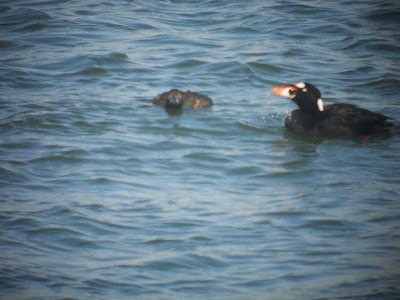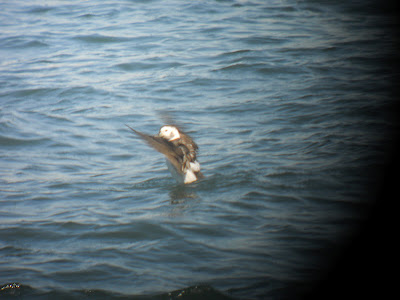On Saturday, April 7th, I went back to Semiahmoo, near the Canadian border. I had the good fortune of meeting a friendly group of birders from the North Cascade Audubon Club. They were happily looking at sea ducks: Long-Tailed Ducks and Surf Scoters.
Long-Tailed Ducks are not commonly seen, unless you spend a lot of time on open water. Their winter range stretches from the coast of Alaska to the coast of Washington. Possibly, a few of these sea ducks may get as far south as northern Oregon. Californians? Forget seeing them. The summer breeding territory is in fresh-water ponds in the high tundra of Alaska and the northern territories of Canada. Like Eider ducks, they line their nests with their down feathers. I felt fortunate to be seeing them.
Male Long-tailed Duck, with characteristic long tail feathers
The leader of the Audubon fieldtrip was Paul Woodcock. He was very knowledgeable and willing to answer my questions. We watched as the Long-Tailed Ducks repeatedly dived. Paul explained that they dive as deep as 200 feet (60 meters) and frequently drown in fishing nets. After I got home, I read in my field guides that they winter near mussel beds and feed on these mollusks. When they arrive at the mussel beds, the young learn the locations of their food source by watching their elders.
My reading led to more questions than answers. These ducks certainly are not diving for mussels at a 200 foot depth. Mussels are intertidal and litoral filter feeders. Also, they must have a different food source in the summer breeding areas, since they are nesting on freshwater ponds in the tundra. One other factor should be considered. Mussels and other mollusks are frequently poisonous in the summer, due to absorption of the 'red-tide' phytoplankton. It would be an evolutionary advantage to have another food source during that season.
Long-Tailed Ducks are unique in having three distinct plumages per year: a breeding plumage (mostly black or very dark brown), a non-breeding, winter plumage (conspicuous white or pale markings on the head) and an 'eclipse' plumage (which means dull colored, post-breeding plumage). Males have long central retrices (tail feathers), while females lack the long tail and their plumage is generally less dramatic than the male.
Male, with Non-Breeding Plumage
The Long-Tailed Ducks were a surprise for me, but I fully expected to see Surf Scoters and was not disappointed. Surf Scoters are common sea ducks. They also are a diving duck, seeking out mollusks and also crustaceans, like small crabs. The males have a striking bill and forehead, which can be seen in this photo.
Male Surf Scoter
The females are almost a monotone, dark brown. Scoters, like many ducks are monogamous.
Surf Scoter Female and Male
Long-Tailed Ducks in Winter Plumage
One of the three Long-Tailed Ducks is showing long tail feathers. It is male.
With spring having arrived, ducks are actively displaying to attract mates, to strengthen pair-bonds, and to challenge other contenders. Often, several male Long-Tails will try to court the same female. Like many ducks, they will dip their head in the water and toss their head back or they will half rise out of the water and flap their wings.
Displaying Long-Tailed Duck
Displaying Long-Tailed Duck
Long-Tailed Duck
It was such a rich day for the Anatidae, which includes geese and ducks, and swans. I counted over 80 Brants (a sea goose) at one location, near Semiahmoo. Brants rely on eel grass for their living. They were feeding on the marine grass in shallow waters.
As a student, I had to do a necropsy on a Brant that died in the Santa Barbara oil spill, so I have a special feeling for these birds.
Black Brant
Flock of Black Brants
I also saw a Yellow-Billed Loon, NOT related to ducks or geese. This bird was in its summer plumage, riding low in the water. It is also a diving bird, eating a wide variety of small creatures.
If you wish to learn more about Semiahmoo and its bird population, go to my blog posting of 11/1/11: Fall Migration at Semiahmoo and Birch Bay.












